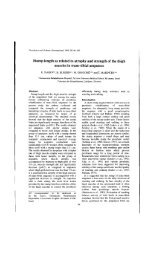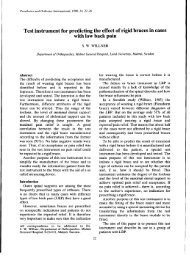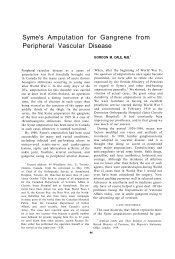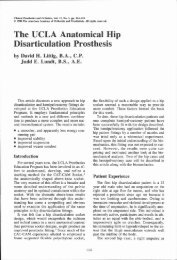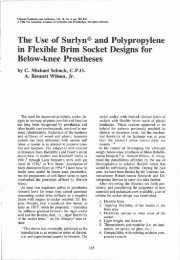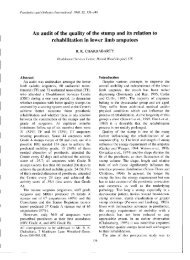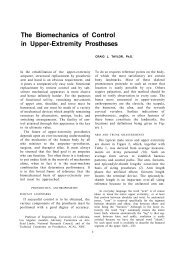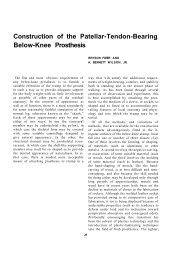Pro-Corn - O&P Library
Pro-Corn - O&P Library
Pro-Corn - O&P Library
You also want an ePaper? Increase the reach of your titles
YUMPU automatically turns print PDFs into web optimized ePapers that Google loves.
arthritics with hand involvement), and removable<br />
Plastizote® insole. There is no heel<br />
counter reinforcement. The indications for this<br />
type of shoe is last resort, severe deformities,<br />
especially in the dorsal aspect of the foot, that<br />
are difficult or impossible to accommodate in<br />
shoes of firmer and less adjustable materials.<br />
Examples of such deformities are severe<br />
hammer toes, severe hallux valgus, and/or<br />
nodules on the dorsum of the feet or toes. This<br />
shoe is fitted slightly large and then heated<br />
while on the patient's foot (with protection by<br />
socks, of course). The application of heat<br />
causes the Dermaplast® to shrink and mold to<br />
the patient's foot shape, thus accommodating<br />
the severe deformity. The shoe upper material<br />
of Plastizote® and fabric is very soft and forgiving<br />
to such deformities. In all cases, we replace<br />
the removable Plastizote® insoles with<br />
molded PVC-Pelite(tm) foot orthoses.<br />
The other style of Apex Ambulators® thermo<br />
adjustable shoes, #1273, is very similar to that<br />
described above. The major difference is the<br />
outer covering of the uppers, which in this<br />
second style is thin, pliable leather. This shoe<br />
is more cosmetically appealing to most patients<br />
because the leather uppers allow the choice of<br />
four colors, (the catalogue number varies with<br />
color variations). It has slightly more integrity<br />
than the #1201 style, including a moderately<br />
reinforced heel counter. It also has a removable<br />
tongue, which is secured in place with<br />
Velcro®, a feature that enhances its adjustability.<br />
It is available with either lace or<br />
Velcro® loop back closure. Accommodation of<br />
deformities can be accomplished either by<br />
heating and shrinking a loose fit as with the<br />
#1201's above or by fitting the shoes to the<br />
proper size and then stretching the uppers with<br />
shoe stretching tools over areas of deformity.<br />
Extra Depth Shoes<br />
Extra Depth® shoes are offered by several<br />
manufacturers and provide greater depth<br />
throughout the entire shoe. This depth is ideal<br />
for accommodating molded foot or ankle foot<br />
orthoses designed for arthritic foot deformities.<br />
Extra depth shoes, like molded AFO's, are a<br />
familiar item in any orthotic practice, and<br />
therefore do not necessitate detailed discussion.<br />
However, there are two important considerations<br />
regarding their application to arthritic patients:<br />
(1) the shoe style selected should be<br />
made of very soft leather, preferably calfskin or<br />
deerskin, as these leathers are most easily spot<br />
stretched to accommodate deformities, and are<br />
the most forgiving to areas of inflammation; (2)<br />
adequate width in the forefoot or toebox of the<br />
shoe cannot be overemphasized.<br />
The extra depth shoes that we recommend<br />
for our arthritic patients are manufactured and<br />
distributed by Alden Shoe Company and P.W.<br />
Minor. The designs and styles vary in leather<br />
utilized, closure (lace or Velcro®), and amount<br />
of heel counter reinforcement. All have soft<br />
crepe soles and uppers that can be modified for<br />
deformities with relative ease using shoe<br />
stretching tools and equipment.<br />
Running<br />
Shoes<br />
Running or jogging shoes should be familiar<br />
to orthotists and patients alike. Their application<br />
to patients with arthritic foot problems<br />
stem from three of their characteristics: (1) they<br />
are acceptable to many patients who do not accept<br />
the "lack of style" of other appropriate<br />
shoes; (2) most utilize separate, removable insoles,<br />
which when removed, allow adequate<br />
room for use of molded foot or ankle foot<br />
orthoses; and (3) most are very light in weight.<br />
<strong>Pro</strong>blems we have encountered with running<br />
shoes include seams in the dorsal aspect of the<br />
toe box, making spot stretching difficult or impossible,<br />
and construction of vinyl or other<br />
synthetic materials which also make stretching<br />
difficult or less successful.<br />
Conclusion and Results<br />
An experience based protocol for orthotic<br />
management of the arthritic foot has been described.<br />
This experience is based on over 300<br />
arthritic patients who required orthotic management<br />
by our service since 1985. Seven patients<br />
have been fit with eight bivalve, weightbearing<br />
rigid, molded AFO's (one bilateral).<br />
One of these seven patients benefitted from a<br />
rigid, molded AFO on his lesser involved lower<br />
extremity. The remaining patients have been<br />
managed with custom molded PVC Pelite(tm)<br />
foot orthoses. Many of the patients fit with<br />
PVC Pelite(tm) foot orthoses were successfully<br />
converted from direct molded Plastizote® shoe<br />
inserts. Through routine follow up and chart re-



